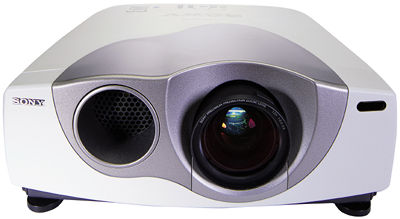Sony VPL-VW11HT LCD projector

The VPL-VW11HT also incorporates Digital Reality Creation Multifunction (DRC-MF), Sony's proprietary video scaler, which comes here in two flavors: DRCx4 and DRC Progressive. The best settings for film-based material were CineMotion in the Auto position and DRC Progressive. (The CineMotion feature engages 3:2 pulldown, but the projector locks on to the 3:2 pulldown sequence faster when you also select the DRC Progressive mode.) The best outboard scalers or progressive-scan DVD players can marginally outperform DRC in reducing artifacts in the most challenging material, but not by much. (The Faroudja processing in the Kenwood DV-5700 DVD player, for example, eliminates jaggies better than DRC on such things as the waving flag on Video Essentials.)
The 11HT also includes a selectable mode called Cinema Black, which slightly reduces the light output. It's said to provide better blacks while doubling the life of the projection lamp. I used it for all of my viewing.
There are six user settings for color temperature: High, Low, and four custom settings. There is also a full set of color-temperature controls in the service menu, with separate red, green, and blue adjustments for the top and bottom of the brightness range.
The VPL-VW11HT can be controlled from the projector itself or via the illuminated remote. The latter is reasonably functional and easy to use, but more utilitarian than the remote on the Grand Wega—largely because, like most projectors, the 11HT has no television tuner of any kind.
Setup
As with most fixed-pixel projectors, setup is fast and easy. Zoom and focus are manually controlled. The projector's throw distance is relatively short: for a 100-inch-diagonal image on a 16:9 screen, the range is 10.7-12.4 feet. The VPL-VW11HT also has digital keystone correction to eliminate the trapezoidal distortion that results when the projector is positioned too high or too low. Ideally, it will be located at approximately the same height as the bottom of the screen—or, for a ceiling mount, near the top.
The cooling fan kicked on noisily but shifted to a very quiet mode within two seconds. The noise level was higher with the Cinema Black mode turned off. The 11HT also had the same slow ramp-up to full brightness as the Grand Wega. Give it a couple of minutes before you freak out and start researching bulb-replacement costs.
On Screen
When I reviewed the VPL-VW10HT for our May 2000 issue, I was very impressed by its performance: "It's the first single-chip LCD or DLP projector I've tested—or even seen—that could compete with CRT projectors in color accuracy and sharpness. And it surpassed even the best of them in usable brightness. . . . The opening, desert scenes in The Fifth Element (the 'Azziz, Light' sequence), for example, looked truly remarkable via the 10HT, with resolution rivaling that of any projector in my experience. The same went for the reconstitution sequence in chapter 9, which looked so close to the best I have ever seen it—including the detail in the cityscape seen as Leeloo climbs out on the ledge and finally jumps—that I had to remind myself several times that I was watching an LCD projector. . . . I have not seen better color from any other LCD or DLP projector, and not much better from CRTs. . . . On my 78-inch-wide screen, I could just make out pixels from about 9 feet away. From my normal viewing distance of just over 12 feet, I couldn't see them at all."























































